
A blue plaque is a permanent sign installed in a public place in the United Kingdom, and certain other countries and territories, to commemorate a link between that location and a famous person, event, or former building on the site, serving as a historical marker. The term is used in the United Kingdom in two senses. It may be used narrowly and specifically to refer to the "official" scheme administered by English Heritage, and restricted to sites within Greater London; or it may be used less formally to encompass a number of similar schemes administered by organisations throughout the UK. The plaques erected are made in a variety of designs, shapes, materials and colours: some are blue, others are not. However, the term "blue plaque" is often used informally to encompass all such schemes.

John Dobson was a 19th-century English neoclassical architect. During his life, he was the most noted architect in Northern England. He designed more than 50 churches and 100 private houses, but he is best known for designing Newcastle railway station and his work with Richard Grainger developing the neoclassical centre of Newcastle. Other notable structures include Nunnykirk Hall, Meldon Park, Mitford Hall, Lilburn Tower, St John the Baptist Church in Otterburn, Northumberland, and Beaufront Castle.

The Royal Grammar School (RGS), Newcastle upon Tyne, is a selective British private day school for pupils aged between 7 and 18 years. Founded in 1525 by Thomas Horsley, the Mayor of Newcastle upon Tyne, it received royal foundation by Queen Elizabeth I and is the city's oldest institution of learning. It is one of seven schools in the United Kingdom to bear the name "Royal Grammar School", of which two others are part of the independent sector.

The Singers Hill Synagogue, officially the Birmingham Hebrew Congregation, is an Orthodox Jewish congregation and synagogue, located at 26, 26A and 26B Blucher Street, in the Birmingham city centre, in the West Midlands of England, in the United Kingdom. The congregation dates from 1780 and worshiped in the Ashkenazi rite.
The Jewish presence in north east England is focused on a number of important towns.
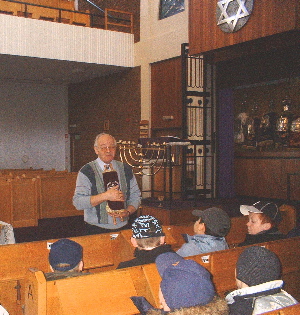
The Giffnock Newton Mearns Synagogue, commonly known as Giffnock Shul, is an Orthodox Jewish congregation and synagogue, located at 222 Fenwick Road in Giffnock, East Renfrewshire, on the south side of Glasgow, Scotland, in the United Kingdom. The synagogue is the largest in Scotland and also features a religious day school for both children and teenagers.

The First Russian Congregation of Rodfei Sholem Anshei Kiev, known as the Kiever Synagogue or Kiever Shul, is a Modern Orthodox Jewish synagogue in Toronto, Ontario, Canada. It was founded by Jewish immigrants from Ukraine in 1912, and formally incorporated in 1914. The congregants were poor working-people, and services were led by members and held in their homes. Two houses were eventually purchased in the Kensington Market area, and in their place construction was completed on the current twin-domed Byzantine Revival building in 1927. The building was once the site of George Taylor Denison's home Bellevue.

Jesmond is a suburb of Newcastle upon Tyne, Tyne and Wear, England, situated north of the city centre and to the east of the Town Moor. Jesmond is considered to be one of the most affluent suburbs of Newcastle upon Tyne, with higher average house prices than most other areas of the city.
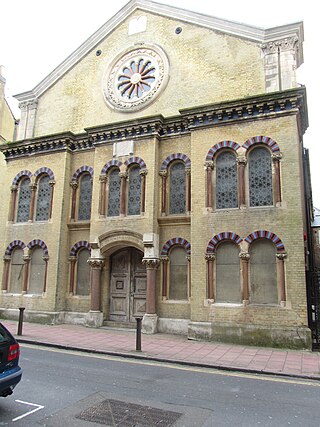
The Middle Street Synagogue is a synagogue in the centre of Brighton, part of the English city of Brighton and Hove. It was the centre for Jewish worship in Brighton and Hove for more than a century. Although it is not in full-time use, the building is still open at certain times, and cultural events frequently take place, as do weddings. It has been listed at Grade II*, reflecting its architectural and historic importance.

The Sunderland Synagogue is a former Orthodox Jewish congregation and synagogue, located on Ryhope Road, in Sunderland, Tyne and Wear, England, in the United Kingdom. The congregation was formed as the Sunderland Hebrew Congregation in 1861 and worshiped in the Ashkenazi rite until the congregation was dissolved in 2006.

The Garnethill Synagogue is an Orthodox Jewish congregation and synagogues located in Garnethill, Glasgow, Scotland, in the United Kingdom. Completed in 1881, the historic synagogue is considered the 'cathedral synagogue' of Scotland.
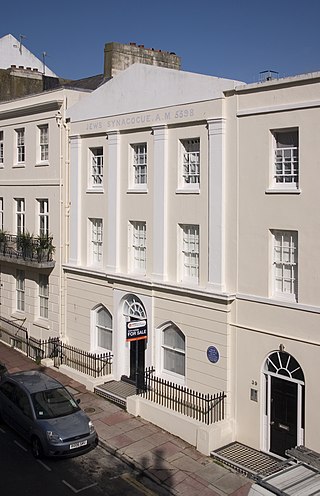
The Brighton Regency Synagogue, also called the Devonshire Place Synagogue, is a former Orthodox Jewish congregation and synagogue, located at 38–39 Devonshire Place, Kemptown, Brighton and Hove, in East Sussex, England, in the United Kingdom. The congregation, established in 1824, worshiped in the Ashkenazi rite.

The Brunswick Terrace Synagogue, also sometimes called the Roof-top synagogue, was a private Orthodox Jewish synagogue that was built on the roof-top of 26 Brunswick Terrace, a terraced-row of houses on the Brunswick Estate in Hove, now a constituent part of the city of Brighton and Hove, in East Sussex, England, in the United Kingdom.
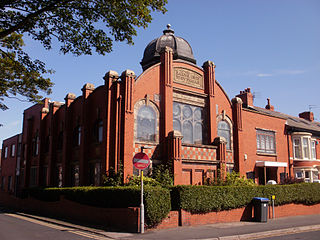
The Blackpool United Hebrew Congregation is a former Orthodox Jewish congregation and synagogue, located on Leamington Road, Blackpool, Lancashire, England, in the United Kingdom. The congregation worshiped in the Ashkenazi rite. The former synagogue building was listed as a Grade II building in 1998.
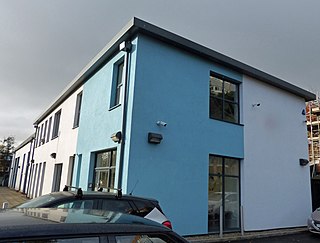
Birmingham Central Synagogue is an Orthodox synagogue situated in Edgbaston, Birmingham, England.
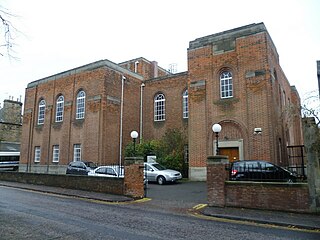
The Edinburgh Synagogue is an Orthodox Jewish congregation and synagogue, located at 4 Salisbury Road in the Newington area of Edinburgh, Scotland, in the United Kingdom. Established in 1816 as the Edinburgh Hebrew Congregation, the congregation worships in the Ashkenazi rite.
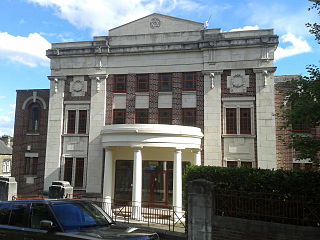
The Wilson Road Synagogue is a former Orthodox Jewish congregation and synagogue, located at 11 Wilson Road, Ecclesall, Sheffield, England, in the United Kingdom. The congregation was formed in 1914 and worshiped in the Ashkenazi rite until the congregation was dissolved in 1997.

The Leazes Park Synagogue is a former Orthodox Jewish congregation and synagogue, located at 12 Leazes Park Road, Newcastle upon Tyne, England, in the United Kingdom. The congregation was formed in 1880 and worshiped in the Ashkenazi rite until the congregation was dissolved in 1978.

Sandyford House is a large office development on Sandyford Road in Sandyford, Newcastle upon Tyne. It was the offices and meeting place of Tyne and Wear County Council from its formation in 1974 until it was abolished in 1986.



















